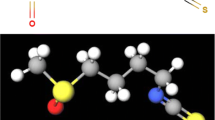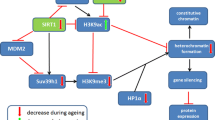Abstract
Aging is a risk factor for human health and quality of life. Screening and development of novel supplements and medications to combat aging and delay the incidence of age-related diseases are of great significance. In this study, salidroside (SA), a primary natural small molecule from Rhodiola rosea, was investigated regarding its effects on life and healthspan and the underlying molecular mechanism(s) of anti-aging and antioxidation. Our results showed that SA effectively prolonged lifespan and exhibited anti-aging and antioxidative properties. Computer-assisted methods, label-free interaction analysis, and in vitro assays showed that SA directly bound heat shock protein 90 (HSP90). Furthermore, SA significantly inhibited the ATPase activity of HSP90, affecting the interaction between HSP90 and its interacting proteins and the expression of downstream genes to regulate lifespan and the oxidative stress response. Our findings provided new insights into the pharmacological properties of SA across multiple species and its potential as an anti-aging drug.








Similar content being viewed by others
Data availability
All data needed to evaluate the conclusions in the paper are present in the main text or the Supplementary Materials. Additional data related to this article may be requested from the authors.
References
Lopez-Otin C, Blasco MA, Partridge L, Serrano M, Kroemer G. Hallmarks of aging: an expanding universe. Cell. 2023;186(2):243–78.
Schmauck-Medina T, Molière A, Lautrup S, Zhang J, Chlopicki S, Madsen HB, Cao S, Soendenbroe C, Mansell E, Vestergaard MB, et al. New hallmarks of ageing: a 2022 Copenhagen ageing meeting summary. Aging. 2022;14(16):6829–39.
Campisi J, Kapahi P, Lithgow GJ, Melov S, Newman JC, Verdin E. From discoveries in ageing research to therapeutics for healthy ageing. Nature. 2019;571(7764):183–92.
Eisenberg T, Knauer H, Schauer A, Buttner S, Ruckenstuhl C, Carmona-Gutierrez D, Ring J, Schroeder S, Magnes C, Antonacci L, et al. Induction of autophagy by spermidine promotes longevity. Nat Cell Biol. 2009;11(11):1305–14.
Ryu D, Mouchiroud L, Andreux PA, Katsyuba E, Moullan N, Nicolet-Dit-Felix AA, Williams EG, Jha P, Lo Sasso G, Huzard D, et al. Urolithin A induces mitophagy and prolongs lifespan in C. elegans and increases muscle function in rodents. Nat Med. 2016;22(8):879–88.
Argyropoulou A, Aligiannis N, Trougakos IP, Skaltsounis AL. Natural compounds with anti-ageing activity. Nat Prod Rep. 2013;30(11):1412–37.
Zhuang W, Yue L, Dang X, Chen F, Gong Y, Lin X, Luo Y. Rosenroot (Rhodiola): Potential applications in aging-related diseases. Aging Dis. 2019;10(1):134–46.
Chen C, Song J, Chen M, Li Z, Tong X, Hu H, Xiang Z, Lu C, Dai F. Rhodiola rosea extends lifespan and improves stress tolerance in silkworm, Bombyx mori. Biogerontology. 2016;17(2):373–81.
Wiegant FA, Surinova S, Ytsma E, Langelaar-Makkinje M, Wikman G, Post JA. Plant adaptogens increase lifespan and stress resistance in C. elegans. Biogerontology. 2009;10(1):27–42.
Dimpfel W, Schombert L, Panossian AG. Assessing the quality and potential efficacy of commercial extracts of Rhodiola rosea L. by analyzing the salidroside and rosavin content and the electrophysiological activity in hippocampal long-term potentiation, a synaptic model of memory. Front Pharmacol. 2018;9:425.
Murphy MP. How mitochondria produce reactive oxygen species. Biochem J. 2009;417(1):1–13.
Hu R, Wang MQ, Ni SH, Wang M, Liu LY, You HY, Wu XH, Wang YJ, Lu L, Wei LB. Salidroside ameliorates endothelial inflammation and oxidative stress by regulating the AMPK/NF-kappaB/NLRP3 signaling pathway in AGEs-induced HUVECs. Eur J Pharmacol. 2020;867:172797.
Mao GX, Xu XG, Wang SY, Li HF, Zhang J, Zhang ZS, Su HL, Chen SS, Xing WM, Wang YZ, et al. Salidroside delays cellular senescence by stimulating mitochondrial biogenesis partly through a miR-22/SIRT-1 pathway. Oxid Med Cell Longev. 2019;2019:5276096.
Jin H, Pei L, Shu X, Yang X, Yan T, Wu Y, Wei N, Yan H, Wang S, Yao C, et al. Therapeutic intervention of learning and memory decays by salidroside stimulation of neurogenesis in aging. Mol Neurobiol. 2016;53(2):851–66.
Zhong Z, Han J, Zhang J, Xiao Q, Hu J, Chen L. Pharmacological activities, mechanisms of action, and safety of salidroside in the central nervous system. Drug Des Dev Ther. 2018;12:1479–89.
Lomenick B, Jung G, Wohlschlegel JA, Huang J. Target identification using drug affinity responsive target stability (DARTS). Curr Protoc Chem Biol. 2011;3(4):163–80.
O’Boyle NM, Banck M, James CA, Morley C, Vandermeersch T, Hutchison GR. Open Babel: an open chemical toolbox. J Cheminform. 2011;3:33.
Waterhouse A, Bertoni M, Bienert S, Studer G, Tauriello G, Gumienny R, Heer FT, de Beer TAP, Rempfer C, Bordoli L, et al. SWISS-MODEL: homology modelling of protein structures and complexes. Nucleic Acids Res. 2018;46(W1):W296–303.
Trott O, Olson AJ. AutoDock Vina: improving the speed and accuracy of docking with a new scoring function, efficient optimization, and multithreading. J Comput Chem. 2010;31(2):455–61.
Seeliger D, de Groot BL. Ligand docking and binding site analysis with PyMOL and Autodock/Vina. J Comput Aided Mol Des. 2010;24(5):417–22.
Yang JH, Hayano M, Griffin PT, Amorim JA, Bonkowski MS, Apostolides JK, Salfati EL, Blanchette M, Munding EM, Bhakta M, et al. Loss of epigenetic information as a cause of mammalian aging. Cell. 2023;186(2):305-326 e327.
Valiathan R, Ashman M, Asthana D. Effects of ageing on the immune system: infants to elderly. Scand J Immunol. 2016;83(4):255–66.
Aherne W, Maloney A, Prodromou C, Rowlands MG, Hardcastle A, Boxall K, Clarke P, Walton MI, Pearl L, Workman P. Assays for HSP90 and inhibitors. Methods Mol Med. 2003;85:149–61.
Davenport J, Manjarrez JR, Peterson L, Krumm B, Blagg BSJ, Matts RL. Gambogic acid, a natural product inhibitor of Hsp90. J Nat Prod. 2011;74(5):1085–92.
Su L, Li H, Huang C, Zhao T, Zhang Y, Ba X, Li Z, Zhang Y, Huang B, Lu J, et al. Muscle-specific histone H3K36 dimethyltransferase SET-18 shortens lifespan of Caenorhabditis elegans by repressing daf-16a expression. Cell Rep. 2018;22(10):2716–29.
Bottino C, Peserico A, Simone C, Caretti G. SMYD3: an oncogenic driver targeting epigenetic regulation and signaling pathways. Cancers (Basel). 2020;12(1):142.
Castro JP, Fernando R, Reeg S, Meinl W, Almeida H, Grune T. Non-enzymatic cleavage of Hsp90 by oxidative stress leads to actin aggregate formation: a novel gain-of-function mechanism. Redox Biol. 2019;21:101108.
Fuhrmann-Stroissnigg H, Niedernhofer LJ, Robbins PD. Hsp90 inhibitors as senolytic drugs to extend healthy aging. Cell Cycle (Georgetown, Tex). 2018;17(9):1048–55.
Profumo E, Buttari B, Tinaburri L, D’Arcangelo D, Sorice M, Capozzi A, Garofalo T, Facchiano A, Businaro R, Kumar P, et al. Oxidative stress induces HSP90 upregulation on the surface of primary human endothelial cells: role of the antioxidant 7,8-dihydroxy-4-methylcoumarin in preventing HSP90 exposure to the immune system. Oxid Med Cell Longev. 2018;2018:2373167.
Madrigal-Matute J, Fernandez-Garcia CE, Gomez-Guerrero C, Lopez-Franco O, Munoz-Garcia B, Egido J, Blanco-Colio LM, Martin-Ventura JL. HSP90 inhibition by 17-DMAG attenuates oxidative stress in experimental atherosclerosis. Cardiovasc Res. 2012;95(1):116–23.
Liu Q, Li Y, Jiang W, Li Y, Zhou L, Song B, Liu X. Inhibition of HSP90 promotes neural stem cell survival from oxidative stress through attenuating NF-kappaB/p65 activation. Oxid Med Cell Longev. 2016;2016:3507290.
Baek SH, Kim JY, Choi JH, Park EM, Han MY, Kim CH, Ahn YS, Park YM. Reduced glutathione oxidation ratio and 8 ohdG accumulation by mild ischemic pretreatment. Brain Res. 2000;856(1–2):28–36.
Austad SN, Fischer KE. Sex differences in lifespan. Cell Metab. 2016;23(6):1022–33.
Bale TL, Epperson CN. Sex differences and stress across the lifespan. Nat Neurosci. 2015;18(10):1413–20.
Ma T, Tian X, Zhang B, Li M, Wang Y, Yang C, Wu J, Wei X, Qu Q, Yu Y, et al. Low-dose metformin targets the lysosomal AMPK pathway through PEN2. Nature. 2022;603(7899):159–65.
Dai X, Yan J, Fu X, Pan Q, Sun D, Xu Y, Wang J, Nie L, Tong L, Shen A, et al. Aspirin inhibits cancer metastasis and angiogenesis via targeting heparanase. Clin Cancer Res. 2017;23(20):6267–78.
Fan F, Yang L, Li R, Zou X, Li N, Meng X, Zhang Y, Wang X. Salidroside as a potential neuroprotective agent for ischemic stroke: a review of sources, pharmacokinetics, mechanism and safety. Biomed Pharmacother. 2020;129:110458.
Li X, Erden O, Li L, Ye Q, Wilson A, Du W. Binding to WGR domain by salidroside activates PARP1 and protects hematopoietic stem cells from oxidative stress. Antioxid Redox Signal. 2014;20(12):1853–65.
Zhang J, Kasim V, Xie YD, Huang C, Sisjayawan J, Dwi Ariyanti A, Yan XS, Wu XY, Liu CP, Yang L, et al. Inhibition of PHD3 by salidroside promotes neovascularization through cell-cell communications mediated by muscle-secreted angiogenic factors. Sci Rep. 2017;7:43935.
Ding XJ, Zhang ZY, Jin J, Han JX, Wang Y, Yang K, Yang YY, Wang HQ, Dai XT, Yao C, et al. Salidroside can target both P4HB-mediated inflammation and melanogenesis of the skin. Theranostics. 2020;10(24):11110–26.
Hoare M, Narita M. The power behind the throne: senescence and the hallmarks of cancer. Ann Rev Cancer Biol. 2018;2(1):175–94.
Janssens GE, Lin XX, Millan-Ariño L, Kavšek A, Sen I, Seinstra RI, Stroustrup N, Nollen EAA, Riedel CG. Transcriptomics-based screening identifies pharmacological inhibition of Hsp90 as a means to defer aging. Cell Rep. 2019;27(2):467-480.e466.
Trepel J, Mollapour M, Giaccone G, Neckers L. Targeting the dynamic HSP90 complex in cancer. Nat Rev Cancer. 2010;10(8):537–49.
Hamamoto R, Furukawa Y, Morita M, Iimura Y, Silva FP, Li M, Yagyu R, Nakamura Y. SMYD3 encodes a histone methyltransferase involved in the proliferation of cancer cells. Nat Cell Biol. 2004;6(8):731–40.
Hu X, Lin S, Yu D, Qiu S, Zhang X, Mei R. A preliminary study: the anti-proliferation effect of salidroside on different human cancer cell lines. Cell Biol Toxicol. 2010;26(6):499–507.
Li L, Wang L, You QD, Xu XL. Heat shock protein 90 inhibitors: an update on achievements, challenges, and future directions. J Med Chem. 2020;63(5):1798–822.
Funding
This project was supported by the National Natural Science Foundation of China (NSFC) to F. D. (No. 31830094) and to J. S. (No. 32272939), Fundamental Research Funds for the central Universities to L. Z. (SWU120011), National Natural Science Foundation of China to L. Z. (No. 32000810), and No. U20A2058 from NSFC to X. T. Additional support was provided by Funds of China Agriculture Research System of MOF and MARA CARS-18-ZJ0102 from the Ministry of Agriculture and Rural Affairs of the People’s Republic of China to F. D.
Author information
Authors and Affiliations
Contributions
F. D. conceived the study. F. D., J. Z., Z. L., J. S., and X. T. designed the experimental plan. J. Z., L. Z., J. S., W. G., and Y. L. performed experiments. T. D. assisted silkworm rearing and feeding experiment. X. C., Z. L., D. T., and T. M. analyzed the data and prepared figures. F. D., J. Z., Z. L., J. S., V. B., and L. J. R. wrote the manuscript. All authors discussed the results at all stages of the manuscript preparation.
Corresponding author
Ethics declarations
Conflict of interest
The authors declare no competing interests.
Additional information
Publisher's Note
Springer Nature remains neutral with regard to jurisdictional claims in published maps and institutional affiliations.
Supplementary Information
Below is the link to the electronic supplementary material.
About this article
Cite this article
Zhang, J., Li, Z., Song, J. et al. Salidroside promotes healthy longevity by interfering with HSP90 activity. GeroScience 46, 1641–1655 (2024). https://doi.org/10.1007/s11357-023-00921-3
Received:
Accepted:
Published:
Issue Date:
DOI: https://doi.org/10.1007/s11357-023-00921-3




